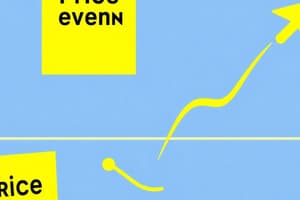Podcast
Questions and Answers
What is the primary characteristic of cost-based pricing?
What is the primary characteristic of cost-based pricing?
- Setting prices based on market demand
- Using competitor prices to determine pricing
- Setting prices based on customer perception
- Adding a standard markup to the cost of the product (correct)
Which pricing strategy aims to achieve specific profit goals?
Which pricing strategy aims to achieve specific profit goals?
- Market Skimming Pricing
- Break-even Pricing (correct)
- Cost-Based Pricing
- Value-Based Pricing
In what scenario is competition-based pricing most commonly used?
In what scenario is competition-based pricing most commonly used?
- In highly competitive markets (correct)
- When costs are significantly high
- In niche markets with few competitors
- In low demand markets
How does value-based pricing determine the selling price of a product?
How does value-based pricing determine the selling price of a product?
What is the main purpose of break-even analysis?
What is the main purpose of break-even analysis?
Which new product pricing strategy involves setting a high price initially and lowering it later?
Which new product pricing strategy involves setting a high price initially and lowering it later?
What does target profit pricing focus on?
What does target profit pricing focus on?
In which pricing strategy is buyer’s perception of value most critical?
In which pricing strategy is buyer’s perception of value most critical?
Flashcards
Cost-Plus Pricing
Cost-Plus Pricing
Adding a standard markup (percentage) to the product's cost to determine the selling price.
Break-Even Point
Break-Even Point
The point where total revenue equals total costs, resulting in neither profit nor loss.
Value-Based Pricing
Value-Based Pricing
Pricing that focuses on the value customers perceive in a product, taking into account non-price factors.
Competition-Based Pricing
Competition-Based Pricing
Signup and view all the flashcards
Market Skimming Pricing
Market Skimming Pricing
Signup and view all the flashcards
Market Penetration Pricing
Market Penetration Pricing
Signup and view all the flashcards
Prestige Pricing
Prestige Pricing
Signup and view all the flashcards
Target Profit Pricing
Target Profit Pricing
Signup and view all the flashcards
Study Notes
Marketing Strategies - Pricing
- Pricing Approaches:
- Cost-Based Pricing
- Break-Even Pricing
- Value-Based Pricing
- Competition-Based Pricing
Cost-Based Pricing
- Simple cost-plus pricing: Add a standard markup to the product cost.
- Hospitality companies often use this approach.
- Example: Food and Beverage (F&B) cost markup is typically 28-32%.
Break-Even Analysis or Target Profit Pricing
- Aims to find the price where a firm breaks even or achieves a target profit.
- Break-even point: Where costs and revenue are equal (no profit or loss).
Break-Even Point Graph
- A graph representing sales and costs versus units sold.
- Shows the break-even point where total costs and sales are equal.
- Identifies the units sold needed to reach the break-even point.
- Shows the profit zone above the break-even point.
- Shows the loss zone below the break-even point.
Questions About Break-Even
- Calculate the number of days to reach the break-even point if 50 units are sold per day.
- Determine the number of days needed to achieve a $10,000 profit if 50 units are sold each day..
- Calculate the number of days required to break even if 50 units are sold daily at a price of $6 per unit.
Value-Based Pricing
- Focuses on the buyer's perception of value.
- Non-price factors build perceived value.
- Trade-off analysis: Assess customer willingness to pay.
- Companies evaluate customer price sensitivity to determine their pricing strategies.
Competition-Based Pricing
- Pricing strategies aligned with competitors' pricing.
- Less focus on costs or demand.
- Used in highly competitive markets.
New Product Pricing Strategies
- Prestige Pricing: Luxurious and elevated products priced high to support their positioning.
- Market-Skimming Pricing: Initially high prices in a price-insensitive market; can be effective short-term. Potential for competitors to enter the market and reduce prices.
- Market-Penetration Pricing: Low initial prices to quickly enter and gain market share in a price-sensitive market; relies on sales volume economics to lower costs.
Studying That Suits You
Use AI to generate personalized quizzes and flashcards to suit your learning preferences.




